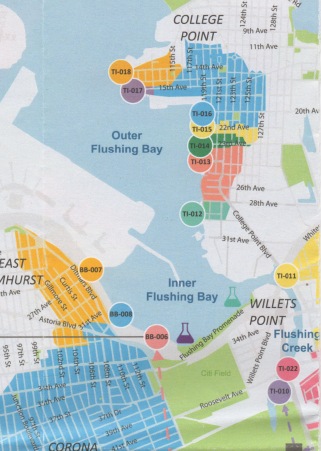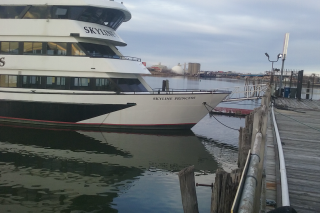
Flushing Bay is ringed by sewer outfalls that discharge untreated sewage during medium and heavy rains. Outfalls are represented by circles of various colors. Graphic by Open Sewer Atlas NYC
By Len Maniace
The coming months are likely to be crucial for the future of two of our city’s most odiferous water bodies, both in name and in fact.
New York State is expected to rule on plans by New York City to clean up Flushing Bay and Flushing Creek, which feeds into it – a decision that is likely to determine conditions in those water bodies for the next 25 years, environmentalists say.
Right now environmentalists are worried. The plan for Flushing Bay has not been released yet; the city’s long-term plan for the Flushing Creek, however, consists of adding disinfectant to the largest of several pipes that periodically dump huge quantities of untreated sewage into the creek.
“You can’t put perfume on the poop and expect to resolve the problem,” said Alexandra Rosa, of Friends of Flushing Creek.
Critics point out that while disinfectants would kill off much of the harmful bacteria in the sewage, they also would damage tiny plant and animal life that are essential to the food chain of a once-productive estuary. What’s more, chlorine disinfectants are not without their own human health hazards.
Rosa was one of more than 100 residents, environmentalists, city officials and boaters attending a community meeting aboard the cruise ship Skyline Princess, docked Saturday in the bay at the World’s Fair Marina.
The trouble with the waters in Flushing Bay and Flushing Creek is hinted at by their names: too much of what is flushed down household toilets ends up in these bodies of water. That’s the case, even with the city’s wastewater treatment plants that were built to prevent the release of sewage into the city’s waterways.

The Empire Dragon Boat Team, a group of breast cancer survivors that’s based on Flushing Bay, urged measures to clean up the polluted water body. Photo by Ruth Fremson/New York Times
While these plants do a great job most of the time, they come up short after moderate or heavy rains. These storms generate so much water that they overload the treatment plants, resulting in sewage being shunted into what are called combined sewer outfalls, CSOs, and then into nearby waterways.
Turns out, Flushing Bay is home to the city’s biggest CSO, which pours out 1.5 billion gallons of sewage and storm water annually. When that’s combined with other nearby CSOs, Flushing Bay receives the most untreated sewage of any body of water in and around our city. As if that isn’t enough, Flushing Creek which eventually flows into the bay, ranks second worse.
Despite the bay’s obvious problems, people use it for recreation, both fishing and boating, including the increasing popular dragon boats. A Chinese tradition, these crafts are attracting a multi-cultural audience in Queens.
Present at Saturday’s event and calling for stepped up effort to clean the bay were members of Empire Dragon Boat Team, a group of breast cancer survivors. For roughly seven years these women have been practicing on Flushing Bay several times a week and competing against other dragon boat teams.
To be clear, city environmental officials have taken steps to clean up Flushing Bay and Creek. Several years ago a huge underground tank was built in nearby Flushing Meadows-Corona Park to temporarily contain some of the sewage during storms until it could then be sent to wastewater treatment plants.

Saturday’s conference on Flushing Bay water quality was sponsored by environmental and neighborhood groups and took place on the Skyline Princess in Flushing Bay.
What’s more the city is investing in green infrastructure that diverts rain and snow melt from even reaching the sewer system: green roofs, permeable paving, and bioswales, which are curbside gardens into which runoff is diverted. In addition the city plans to dredge a portion of the bay.
More needs to be done to reduce the amount of sewage released into the bay and creek, said Sean Dixon, an attorney with Riverkeeper, a group dedicated to protecting the Hudson River and its estuary. And with the city and state soon to finalize cleanup measures governing Flushing Bay and Creek for a generation, citizen action is needed to do the job right, he said.
“It’s important to tell officials that we want to start the cleanup today,” Dixon said.
The event was sponsored by Guardians of Flushing Bay; S.W.I.M. Coalition (Storm Water Infrastructure Matters); Riverkeeper, and Skyline Cruises.